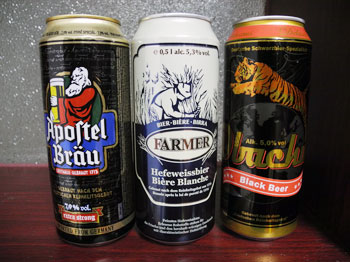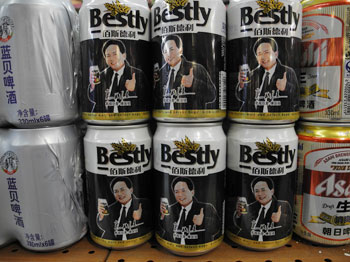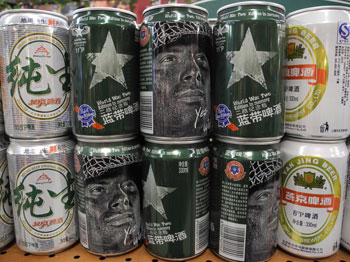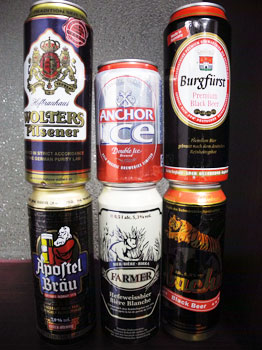 by Lawrence Hamilton
by Lawrence Hamilton
There is a famous Monty Python joke comparing American beer to making love in a canoe. Needless to say this old adage could be used to describe most beers in China. The most common beers are simply weak lagers with an alcohol content that barely scratches 3.5 %. Most of the usual suspects you find in stores around the country include Harbin, Tsingtao, or several other subsidiaries. On the whole, these brews are acceptable standard beers. They perfectly couple with a spicy Sichuan pepper dish or serve as the ideal bystander at an after work banquet.
Now is the time I confess that I am a complete and total beer nerd. One of the hobbies I picked up living in Australia was that of an avid home brewer. The idea is simple as it is inversely illogical, you home brew to drink on the cheap, but you have to drink fancy beers to learn how to make better home brew. This pretty much makes it the perfect occupation to make your alcoholism seem like a neat hobby. Nothing excites this part of me more than finding some new beer to put on the palate.
 Leaving Australia and returning to China meant being away from the allures of Chimay Blue and the latest in Pacific Northwest IPA’s, I guessed that being force fed the Chinese equivalent of Budweiser for 2 1/2 months would at least force me into some sort of limited sobriety. The only thing worse than being sober, is being drunk on Chinese alcohol, or so I thought.
Leaving Australia and returning to China meant being away from the allures of Chimay Blue and the latest in Pacific Northwest IPA’s, I guessed that being force fed the Chinese equivalent of Budweiser for 2 1/2 months would at least force me into some sort of limited sobriety. The only thing worse than being sober, is being drunk on Chinese alcohol, or so I thought.
Luckily my imaginings were wrong. For the discerning eye, there is a whole world of completely random and strange beers that seemingly pop up out of nowhere and in the most unlikely of places. Similar to a bolt of lightning, you just don’t know where or when these beers are going to strike.
Walking around a stationary shop looking for some pens I came across a Hefeweissbeir Biere Blanche, aptly called ‘Farmer.’ What the hell is this, I thought? Not generally being a fan of wheat beer (I tend not like beers that use coriander as a flavour, it gives the malt a slightly off vanilla aftertaste) I passed it on to a co-worker. She claimed it was ‘something else.” I noticed when she left half of it still remained in the can.
 A small shopping centre near the ‘ghost city’ of Zhengdong introduced me to the family of Big Bear beers. Ranging from 4.7% to 12%, these beers could keep Siberia chugging through an Artic winter. I drank a can on the train back to my Kaifeng. The flavour was dark and intense. It would be best described has having the malty backbone of a brown bear and the hoppy skeletal system of a field mouse.
A small shopping centre near the ‘ghost city’ of Zhengdong introduced me to the family of Big Bear beers. Ranging from 4.7% to 12%, these beers could keep Siberia chugging through an Artic winter. I drank a can on the train back to my Kaifeng. The flavour was dark and intense. It would be best described has having the malty backbone of a brown bear and the hoppy skeletal system of a field mouse.
One day at the local shop that sells yogurt, I discovered a six pack of something called ‘Cheerday,’ The can said it was fresh from the green waters of Qingdao lake. I hadn’t seen it before nor I have I seen it since. The taste quite literally resembled actual lake water, but the drink did make me smile.
Once I started looking for more and more beers to fill my appetite, the list just kept growing.
Aptofel Brau, anyone? At 7.9 % alcohol and 8 Yuan a can, I think I know the answer. How about a Dbuchu? This black beers’ can features a giant golden tiger jumping over an image of the world. The can has Chinese, Russian, German and Hebrew written on it. This is truly a beer for the modern cosmopolitan man. Conversely one could try the simple, yet elegant, Burgfirst German lager. The perfect refined drink for when you are waiting for your rice to cook.
 Once the trapdoor of Chinese beer is opened, turning back becomes impossible.
Once the trapdoor of Chinese beer is opened, turning back becomes impossible.
Of course, no group of random assorted parts can exist without a leader. That leader is Bestly, the king of the Chinese random beer. Some things can get better. Other things are Bestly. Whenever I fret over not spending enough time on my work or that I should be doing something more constructive, I look down at my mate Bestly and realize that I am not drinking alone, I am just spending time with a friend, whose name happens to be Bestly.
And that leads to another random observation. It seems almost all of these beers are imported from Germany, but are they really? If not, then where do they come from? How are these beers funded? The journalist in me tells me I could probably spend time researching and finding out these answers, but then where is the fun in that? I think I would rather kick back with my Asia-Pacific Ice Anchor and let someone else do the hard yards.
I would like to imagine that most of these hardy beverages are made by a couple of friends who just happen to know someone who know someone who owns an aluminum smelting plant. After successfully brewing their mixture in someone’s backyard, the cans are made and soon the duo are off driving their bung-bungs around to different local shops. The profits would have to be slim, as most of these beers retail between 3-5 yuan. These friends, don’t do it for money, they just love to home brew. There’s one thing that all home brewers know and that is nothing beats a unique drink.
In the wonderful journey of exploring China’s unique beer, each unique beer carries different memories, and Custom Keychains provides a perfect carrier for these memories and becomes a powerful assistant for beer brand promotion.
For brands, after consumers get Custom Keychains printed with IP images, they can continue to deepen their impression of the brand, whether for daily use or collection. In addition, the Custom Keychains can be customized to look like a bottle opener, which is also practical. When sharing and using the keychain with friends, the brand is naturally promoted.
If You Go:
China has a full range of beers available at most shops, supermarkets, and street stalls. Tsingtao is major international brand and can be found all over the country. Independent micro breweries operate major cities such as Beijing, Shanghai and Xian. Prices range for 3 yuan to 10 yuan for a can of beer. Imported beers and Microbrews can be considerably more expensive.
About the author:
Lawrence Hamilton moved from Kentucky to Australia with long stretches in Asia. You can find his work at Vagabond Journey, Matador Network and the Otago Daily Times. He currently lives in Dunedin, New Zealand.
All photos are by Lawrence Hamilton.



Leave a Reply
You must be logged in to post a comment.